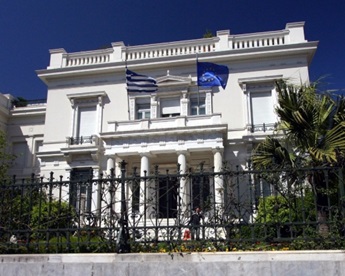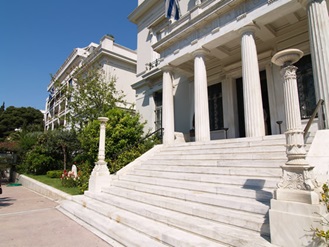Benaki Museum (central building)

The Benaki Museum is set in a neoclassical building which was completed in 1895 by the architecture Metaxas. It was known as Harokopos mansion until it was bought by the Benaki family in 1910. New wings were added to the original building which eventually in 1930 was transformed into a museum. The Benaki Museum holds several permanent collections. It also organizes interesting exhibitions usually of contemporary art.
On the ground floor the first two rooms present the prehistoric collection of the museum. More specifically in the first room the visitor will be able to see tools, figurines and vases form the Neolithic Greece (circa 6.500 B.C.). The second room has Cycladic vases and some examples of the famous marble figurines (circa 3200 B.C.). Here, Mycenaean jewelry and vases are also presented. Moreover there are some vases with geometric decoration. The rooms 3, 4, 5 and 6 are devoted mostly to the classical Greece. They display black and red figure vases, fractures of sculpture of the era and some jewelry that was discovered in “thesaurus”. The rooms 7, 8 and 9 cover the Hellenistic and Roman period. Here, vases, fragments of sculpture and jewelry are presented. In room number 8 there are some carved plaques made of bone. These were inlaid in wooden furniture. This kind of furniture decoration indicates the opulence of the life style in the Roman Empire. The same opulence is obvious in the heavy gold jewelry on display in the next room. In this room some portraits of the dead (fayums) of the Roman period along with samples of the early Byzantine icons are displayed. In this way the visitor can witness first-had the huge influence that the fayums had on Byzantine painting. The rest rooms of the ground floor hold the Byzantine collection. Manuscripts, jewelry, mosaics of the 7th and 8th century can be seen. The visitor can also admire Byzantine icons and precious, ornate crosses and vessels of the 13th, 14th and 15th century A.D..
The first floor is dedicated to the 17th, 18th and 19th century of Greece. Most rooms have on display the clothing and the furniture that was typical in various areas of Greece during this period. In some rooms one can find small paintings and sketches with landscape form Greece made by foreign travelers. In the room 21 the visitor can see a kind of hand carried carriage that belonged to the wife of the administrator of the Corfu Island. Very impressive are also the rooms 17 and 19. Both of them are reconstructions of the reception area of wealthy houses of Kozani of the 18th century. Wooden, heavily carved furniture and walls convey to the spectator the wealth and the luxury of these houses.
On the second are usually set the various exhibitions that are organized periodically by the museum. Here, the café-restaurant of the museum is situated. It has an extended balcony with a view to the city of Athens.
On the third floor there are historic paintings that represent battles of the struggle of Greeks against the Turkish dominion. The visitor can admire some of the painting of Bryzakis, the first important Greek painter of the New Greek State. There are also portraits of the most known captains and politicians of the newly founded Greek state. The official royal court clothing can also be seen here. At the back of this room there are some paintings of Parthenis and Gyzis, two famous Greek painters of the 19th century.
Tip: The café –restaurant of the museum is accessible even without paying the fee-entrance of the museum. While it offers great quality, its' prices are rather high. On weekend mornings you will probably find middle aged high class women of the nearby area (Kolonaki) enjoying their coffee.
Address: 1 Koumpari & Vasilissis Sofias, 10674 Athens
Admission: 6 €
Schedule: Monday, Wednesday, Friday, Saturday: 9:00 - 17:00 Thursday: 9:00 - 24:00 Sunday: 9:00 - 15:00
E-Mail: benaki@benaki.gr
Phone: (+30) 210-367-1000
Webpage: http://www.benaki.gr/

Back